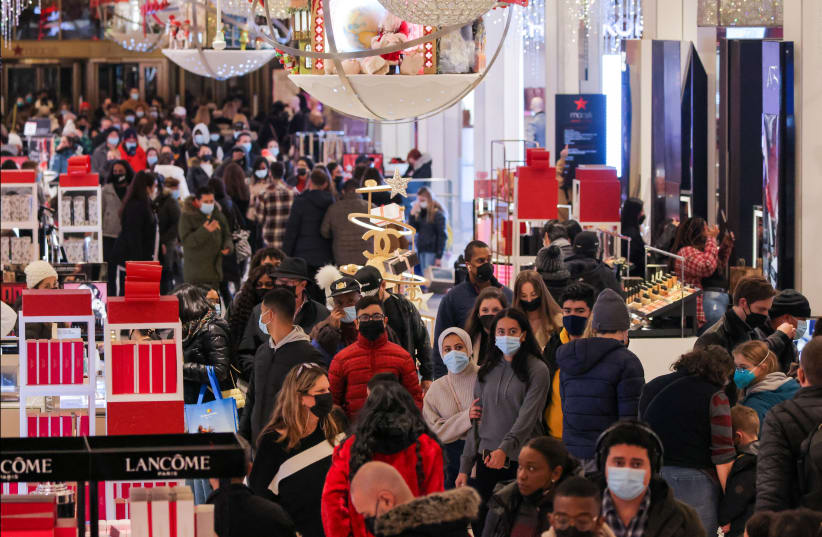When it comes to things that make consumers anxious, the threat of higher prices is edging out the fear of losing a paycheck.
Asked whether inflation or unemployment was the more serious problem facing the nation, 75% of consumers picked inflation, according to the University of Michigan Surveys of Consumers in December.
And 27% of households — the highest in nine years — complained that rising prices had lowered their standard of living.
For decades, the major financial threat for many families included the fear of seeing a company go out of business, dealing with getting laid off or facing a painful time finding a good job out of college.
Now, skyrocketing energy costs, soaring food prices, sharp price hikes for new and used cars, rising monthly rents and shocking prices at the pump all threaten to cut into our budgets and greatly influence our daily lives.
While inflation rates are nowhere near the double-digit disaster in 1980 and 1981, consumers are often shocked now to pay more for many things they buy regularly.
Handing over more money for a long list of everyday expenses means you need to cut back somewhere else — or give up something you need or really would like to do or buy.
Most people don't feel better off financially, even if they're working, if they're stressed out when they're buying goods or services that they could easily afford a few years ago.
Rapid inflation is something many consumers 40 and younger never really experienced. But they're getting an up close look every time they go out to eat, fill up the car with gas or even consider buying new clothes to go back to the office.
Peanut butter shot up 6.8% in the past 12 months ending in November; apples, up 7.4%; fresh fish and seafood, up 10.6%; women's dresses, up 8.6%; men's suits and outerwear, up 14.1% and car and truck rental rates are up 37.2%, according to the U.S. Bureau of Labor Statistics.
We've been looking at a fairly decent uptick in prices for eight months overall.
The Consumer Price Index rose 6.8% for the 12 months ending in November — the largest jump since June 1982.
The CPI for the 12 months ending in December is scheduled to be released Wednesday.
The national unemployment rate was 4.2% in November.
Inflation is called a 'regressive tax'
"It's awful if you're a low income consumer. It's just devastating," U-M economist Richard Curtin, director of the surveys, said in an interview with the Free Press.
Inflation, he said, is often referred to as a "regressive tax" because it hurts the lowest income groups the worst.
Lower income families, for example, are more likely to rent and face budget shocks when rental rates go up and they find it tougher to deal with skyrocketing energy costs. They don't have much extra money sitting on the sidelines to cover spikes in gas or food prices.
Higher income households, by contrast, often can afford to simply shrug it off and just pay more to get what they want. Or they can stop spending on some luxury goods when they're smacked with sticker shock, such as outrageous prices for lobster or steak.
Many younger consumers tend to start out in lower paying jobs and could face more financial challenges as prices go up, too, Curtin said. And while they might expect to make more money in the future, it doesn't help many cover higher costs now.
Sure, many people are seeing raises. But wage gains for most families won't outpace inflation.
Just 15% of all consumers in the University of Michigan Surveys of Consumers anticipated that their household's income would rise faster than inflation in the year-end survey. This was the lowest figure recorded in eight years.
The University of Michigan Surveys of Consumers released a few days before Christmas indicated that consumers were slightly more optimistic in December. But that was before the latest surge in coronavirus cases fueled by the omicron variant.
The Consumer Sentiment Index rose to 70.6 in the December survey, up slightly from November's 67.4. But it's important to note that the key indicator was substantially below last year's 80.7.
How consumers feel about their finances can be key to anticipating whether they're going to be willing to spend their money or save it.
Why we're all so anxious
Consumers may be wise to think about how they're going to cover higher prices ahead in 2022 and beyond, as these price hikes aren't expected to be temporary.
"The era of low unemployment and low inflation was a very pleasant era but that era is over," Curtin said.
Curtin said the renewed optimism of consumers in the December survey was due to higher than expected income gains during 2022. But he warned that those anticipated gains may be vulnerable if people end up working fewer hours for a period of time as a result of the rapidly spreading omicron variant.
In 2022, Curtin said, the survey will be keeping a close eye on how consumers respond to inflation and what's expected to be a gradual uptick in interest rates.
"The main issue is how they're going to react to interest rates and inflation; we know both will be rising," Curtin said.
Typically, consumers have had two different types of reactions to higher prices. In the 1950s, Curtin said, consumers tended to pull back and save more money.
In the 1970s and early 1980s, many consumers stepped up their spending to buy in advance of future price hikes.
"That buy in advance cycle is something that the Fed fears," Curtin said.
The political discussion is likely to be intense as well.
The U-M survey indicated that Democrats anticipate much lower inflation rates than Republicans for the year ahead and over the longer term. Moreover, the survey noted that, three times as many Republicans as Democrats cited the negative impact on their finances from inflation (47% vs. 16%).
Consumer prices rose but 1.4% in the 12 months through January 2021 when President Joe Biden took office.
Inflation — and higher prices — took off in the spring, as the CPI rose by 4.2% in April from a year earlier.
The COVID-related shutdowns began disrupting supply in early 2020 and we saw a continued problem in 2021.
On top of that, the stimulus packages out of Washington — including the monthly advance payments for the child tax credit — left many families with more cash to spend, driving the demand for many goods. For many months, the ability to spend on experiences like travel and entertainment was limited by the pandemic.
Some of the upward spiral in prices where we're seeing a surge in consumer demand and lagging supply can be blamed on the pandemic. And the virus itself will continue to play a role in the overall economy and influence prices.
Economists remain concerned that if the pandemic isn't under control many people will continue to stay out of the work force, contributing to a shortage of workers and driving up costs.
The Federal Reserve is under more pressure to take its foot off the gas by raising interest rates to slow down inflation. Many economists expect the Fed to raise short term interest rates three times in 2022.
Some expect the rate hikes to start in the second quarter of 2022, either at the end of April or mid-June. But lately, we're hearing some say that the first in the series of small rate hikes could take place at the Fed's two-day meeting on March 15-16.


